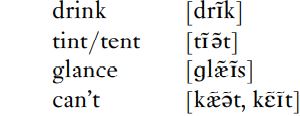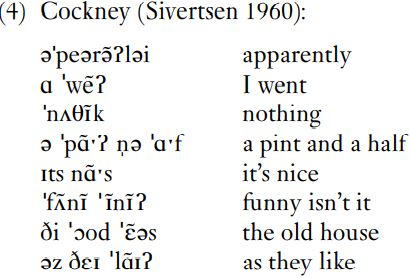


 Grammar
Grammar
 Tenses
Tenses
 Present
Present
 Past
Past
 Future
Future
 Parts Of Speech
Parts Of Speech
 Nouns
Nouns
 Verbs
Verbs
 Adverbs
Adverbs
 Adjectives
Adjectives
 Pronouns
Pronouns
 Pre Position
Pre Position
 Preposition by function
Preposition by function 
 Preposition by construction
Preposition by construction
 Conjunctions
Conjunctions
 Interjections
Interjections
 Grammar Rules
Grammar Rules
 Linguistics
Linguistics
 Semantics
Semantics
 Pragmatics
Pragmatics
 Reading Comprehension
Reading Comprehension|
Read More
Date: 2023-10-25
Date: 9-6-2022
Date: 2023-06-09
|
In some varieties of English, syllable-final nasal consonants do not always occur, but are manifest only through the nasalization of vowels. This phenomenon is reported for English in the Southern USA (Wells 1982: 541), where a sequence of vowel + nasal + voiceless plosive can be produced as a nasalized vowel + voiceless plosive. All the same ‘ingredients’ are present, but they are reordered in time so that nasal airflow occurs concurrently with the open resonant articulation needed for the vowel, and there is no discrete portion which has nasality + closure. (This variety, in common with many others in the USA, has vocalic on-glides into some consonants.)


This can be seen as a ‘natural’ process, in that it has a simple phonetic explanation: the velum lowers early, producing nasality + vocalicity followed by nasality + a stop articulation.
Here are some examples taken from Cockney English (the traditional dialect of London, especially the eastern part of the city), recorded in the early 1950s from the speech of people born in the 1890s (Sivertsen 1960). What is recorded here, then, is ‘conservative’ or ‘traditional’, from a modern perspective. The distribution of nasalization in Cockney is under-researched: it occurs in the context of nasal consonants, and is commonly found on open vowels; it is also a property of the voice quality used by Cockney speakers. The transcriptions have been simplified a little.

It can be seen from these transcriptions that some vowels are nasalized in words which in the spelling contain nasals: ‘apparently’, ‘went’, ‘pint’ are all examples of this. Then there are words where there is nasalization also after a nasal consonant, as in ‘funny’, ‘isn’t it’ and ‘nice’. But there are also words with nasalized vowels where there is no nasal in the spelling: ‘house’ and ‘like’ are examples of this. These details are very characteristic of this dialect, and they show that sometimes phonetic parameters do not behave in the same way in all varieties.
|
|
|
|
4 أسباب تجعلك تضيف الزنجبيل إلى طعامك.. تعرف عليها
|
|
|
|
|
|
|
أكبر محطة للطاقة الكهرومائية في بريطانيا تستعد للانطلاق
|
|
|
|
|
|
|
العتبة العباسية المقدسة تبحث مع العتبة الحسينية المقدسة التنسيق المشترك لإقامة حفل تخرج طلبة الجامعات
|
|
|